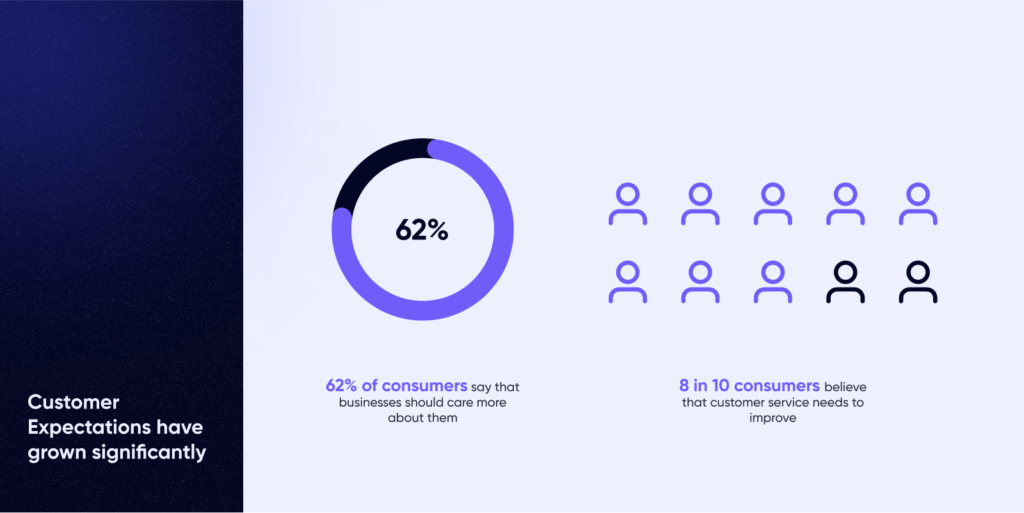Nowadays, great customer service is more important than it ever was. In 2025, businesses are understanding that the backbone of a successful business is happy customers. A customer’s experience can either break or make a business.
A customer starts a conversation with a brand on Instagram during their commute. Later, they follow up on the same query via email and confirm the details through WhatsApp—without having to repeat themselves. Each interaction picks up where the last one left off, no matter the channel.
This is what customers expect now: a smooth, connected experience across platforms. As more people rely on multiple touchpoints—social media, live chat, email, messaging apps—businesses need to ensure consistency and context in every conversation.
In 2025, customer service trends are pointing clearly in one direction: towards an omnichannel self-service portal that keeps pace with customer behaviour.
According to Forbes, 97 % of customers assert that good customer service is vital for brand loyalty. This indicates the importance of customer service–that customers give the same weight to the experience that a company gives as to the goods or services that a company offers.
Now providing extraordinary customer experiences isn’t simply a ‘nice to have’, but a necessity. According to Forrester’s research, companies that thrive in customer experience increase revenue three times faster than those with weak customer experience strategies.

In fact, PWC states that one bad experience can make 32% of customers stop their relationship with the brand they used to like. Consumer loyalty is not the same concept as it once was — in today’s hyperconnected world, switching to a competitor is as easy as clicking a button.
So, let us see how businesses can stay ahead of their competitors by understanding the customer service trends in 2025
12 Top Customer Service Trends
As per a report by Zendesk, 79% of agents believe that AI Co-pilot adoption has helped them even resolve L2 and L3 queries faster, and deliver the best support experience possible. But when it comes to L1 queries, customers do still expect instant responses but now they want it to be more humane, this is driven by generative AI.
Trend #1: Smart Self-Serve Options
Self-service options stand as the first among emerging customer support trends. It presents a lot of benefits for both customers and businesses. They provide the customers with the ability to solve their own problems without human interaction or concern with long wait times. The Harvard Business Review reports that 81% of customers with problems try taking care of things on their own- most across industries.
For businesses, ready smart self-serve options reduce the stress of support teams, which can now focus their time on complex inquiries and strategic tasks. Also, the self-service systems can access useful data about customer interaction, preferences and trouble spots which is valuable for process optimisation and product/service improvement.
Smart self-serve options are enabled by a number of tools and technologies such as self-service portals, knowledge bases, interactive FAQs, chatbots, and voice assistants. These solutions make use of AI and NLP algorithms to understand and attend to customer issues effortlessly, providing customers with smooth and intuitive self-service experiences.
Trend #2: AI-powered Centralised Insights
Customer data centralisation and insights provide companies with an all-encompassing picture of their customer base. Companies can do this by combining data from multiple sources like CRM systems, social media platforms, website analytics, and transaction logs.
As a result, detailed customer profiles and trends, patterns and correlations can be spotted. These insights allow businesses to personalise marketing campaigns, match product/service offerings, preempt customer needs, and improve overall customer experience.
On top of that, centralised data improves decision-making processes in every department, leading to fully informed strategies and resource allocation.
Trend #3: Generative AI Taking the Centre Stage for Conversational Support
The support automation using Generative AI technology is one of the major improvements in the field of customer services. These systems can understand the natural language inputs, give relevant contextual responses and have conversations with customers which are meaningful. Thus, Generative AI is a powerful tool to resolve customer queries effortlessly.
Mckinsey states in their research “We value the increase in productivity at a range from 30% to 45% of the current function costs by using generative AI in customer care functions.”
Through the use of generative AI, businesses can offer round-the-clock support, handle a larger quantity of inquiries at a time, and provide consistent and personalised replies across channels. This not only leads to better customer satisfaction in terms of reducing the waiting time and better service experience but also enhances the productivity and scalability of businesses.
Trend #4: Growth of Omnichannel Support
Omnichannel support provides multiple advantages for businesses as well as customers. Customers can have a seamless experience with omnichannel service as they can interact with the brands they prefer through the communication platforms they want.
Research done by Think with Google showed that omnichannel strategies bring to the stores about 80% of visits by customers.
Through email, phone, chat or social media or personally, consumers wish the experiences to be the same and cohesive on all the interaction levels. For businesses, omnichannel support facilitates more enhanced customer interaction, a deeper understanding of customer journeys, and more efficient strategies of communication.
And even more than that, as per Shopify, solid omnichannel brands have been found to decrease the cost per contact by 7.5% on an annual basis. Despite that, only 11% of companies state that they have comprehensive omnichannel support.
The business benefits of omnichannel support are endless. It is of utmost importance for companies to meet their customers on their preferred platforms, this will help them stay competitive in the market.
Trend #5: Holistic Support with Customer Journey Mapping
Customer journey mapping entails finding and identifying the multiple touchpoints and interactions that the customer goes through while relating to a brand. This process usually includes the stages of awareness, consideration, purchase and post-purchase together with the feelings and pain points that arise at each of the stages.
Tracking the customer journey requires collecting data from various channels such as customer feedback, surveys, analytics, and personal observation.
Customer journey mapping is a key element in the process of looking for ways to improve the customer support processes of businesses. The journey mapping paves way for the businesses to design more purposeful and personalised service strategies which are in sync with customer needs and choices.
Indeed, customer journey mapping allows businesses to create more meaningful connections with customers and enhance their satisfaction and loyalty which in turn leads to the long-term achievements of the business.
Trend #6: Personalisation in Customer Experience (CX)
The role of personalised customer experience is becoming a critical factor for businesses keen on creating a competitive advantage. Through tailoring products, services, and engagement to customers’ tastes and preferences, businesses can boost their customer satisfaction, loyalty, and lifetime value.
73% of customers prefer to do business with businesses that use personal information to personalise their shopping experiences.
Personalisation allows businesses to send relevant content, recommendations, and promotions to customers at the right time. This in turn increases the likelihood of conversion and repeat purchases.
Along with this, it follows that customised experiences generate stronger emotional connections between customers and the brand, which becomes the basis for more brand advocacy and positive word-of-mouth referrals.
Trend #7: Automation for Better Agent Efficiency
Automation improves the productivity of agents and streamlines support operations as well. Through the automation of recurring tasks such as ticket routing, data entry, and basic questions, businesses can liberate agents to deal with higher-degree problems that need the involvement of people.
This will not only minimise the response times and in turn ensure that businesses are boosting their customer relationship while also enhancing their productivity and satisfaction.
Moreover, automation allows businesses to increase the efficiency of their support services by handling higher volumes of inquiries without a significant increase in the number of employees. Eventually, that will lead to cost savings, better resource allocation, and more accurate allocation of resources to customers’ needs.
Trend #8: Increased Investments In Customer Service
As per Zendesk, 80% of companies want to boost their investment in customer experience (CX). This is because investing in customer service produces a lot of benefits for enterprises on numerous factors. This, in turn, signals a priority for customer satisfaction and loyalty, which helps in building brand reputation and brand differentiation in the market.
Customer experience trends are going to be an important factor in 2024 to govern how customers are going to interact with your business. Besides, investing in technologies of customer service and training programs that have better quality and efficiency results in higher customer satisfaction scores and retention rates. This is proven as reported by Gartner that 80% of firms intend to compete on the basis of customer experience!
As a matter of fact, relying on customer service helps achieve revenue growth objectives through an increase in cross-selling and upselling opportunities as satisfied customers are more likely to buy additional products and services and refer the brand to their friends.
Trend #9: Video Bases Customer Expectations
The technological advancements in video support are changing the way business connects with clients. According to a Wyzowl survey, 86% of respondents have been convinced to purchase a product or service after seeing a descriptive video. This clearly underscores the importance of video content in influencing customer behaviour.
From live video chat to screen sharing and augmented reality, video-based support brings a more engaging and interactive experience to customers.
These technologies allow agents to give customers a visual guide, solve technical problems on the spot, and provide individualised advice, which leads to a greater number of satisfied customers.
Trend #10: Sustainable Customer Satisfaction
Sustainable customer satisfaction is a vital part of sound business management. Continuously meeting or surpassing customer expectations will lead to such elements as loyalty, advocacy, and positive word-of-mouth referrals.
Loyal customers are more likely to stick to a brand, buy more products and services, and recommend the brand to others, eventually leading to stable revenue growth and profits. Besides, involvement in customer satisfaction activities could result in operational productivity, cost reduction, and gain of an edge in the industry.
Trend #11: Improvement In Data Privacy and Security
Data privacy and security are the key issues both for the companies and the customers. Businesses must be attentive to regulatory requirements and consumer concerns over data protection while giving priority to data privacy to nurture trust and credibility.
According to the 2023 CISCO Data Privacy Benchmark Study, 95% of respondents consider privacy to be a business essential, and 94% say consumers would not buy from them if data is not effectively secured.
Implementing strong data security measures, complying with regulations like GDPR and CCPA, and informing the customers about the data handling process will build confidence, avoid data breach risks, and prevent any costly penalties or reputation loss.
Trend #12: Emotionally Intelligent Customer Service
Emotionally intelligent customer service is achieved by knowing and relating to the customers’ feelings, situations, and desires. Through showing empathy, active listening, and concern for customers’ health, support operators may build trust and loyalty in their customers. And how to achieve that? The best way is to incorporate gen AI in customer service. These AI models are capable of handling conversation more emotionally.
Emotional intelligence in customer service not only enriches the customers’ overall experience but also defuses tense situations, prevents escalations, and cultivates trust between customers and the brand.
Finally, businesses that make emotional intelligence part of their customer service will stand out from the rest and create long-term impressions that spur customer satisfaction and loyalty.
Additional Customer Service Insights
- In 2024 AI agent adoption has increased to 49% as compared to 17% in 2023.
- 67% of consumers believe that creativity, empathy and friendliness are important when they converse with AI agents.
- 81% customers expect AI support from businesses.
- 74% of customers also prefer interacting with Voice AI and say it would help improve their experience.
- As per Gartner the top customer service trend is the adoption of conversational generative AI solutions for automating customer engagement.
- The Gartner, the customer service top trends reports surveyor say that only 3% of them have prioritised sharing customer data, company-wide. And the rest of them indicated that not sharing is impacting their services.
Why Businesses Should Revamp their Customer Service Strategy?
Customer service is like the adhesive that binds a relationship between a business and its consumers. It is all in how a company handles you when you have questions or need assistance.
Think about it: we all enjoy and appreciate sincere efforts to satisfy our needs, isn’t it? You can start to rely on them more because you are aware they are looking out for you.
Good customer service is similar to having a friend who will always be there for you. They are there when you need them, they are honest with you, and they make you feel appreciated.
Yet in situations when a minor challenge occurs, which is bound to happen from time to time, a business that takes responsibility and tries to rectify it gains even more credibility. It shows they are responsible and willing to do things right.
Besides customer service, transparency and accountability also contribute to the process further, increasing trust. When businesses are clear and upfront with customers in their communications, especially when it comes to resolving complaints or addressing issues, it sends a signal to consumers that the brand can rely on integrity to act.
By taking ownership of their mistakes and actively seeking solutions, businesses demonstrate that they are duty-bound for their actions. This in turn builds trust in the company.
Moreover, good customer service experiences generate emotional bonds that are also helpful in the process of building trust. The consumer feels both listened to and considered by support personnel, which fosters brand loyalty.
Build Customer Service Strategy for 2025
With customer service trends evolving, businesses will have to be flexible to keep up with the dynamic customer needs. With smart self-serve solutions, AI-based insights, and multi-channel support, companies are able to build great customer experiences and long-term connections.
Trust and loyalty can be effectively built when business organisations are dedicated to personalised engagements, proactive support, and sustainable satisfaction. By applying technology, data-driven insights, and also emotional intelligence, organisations are positioned to remain competitive and excel in the digital era.
With Verloop.io, don’t just stay updated with the current market trends, but also with the latest customer support automation technologies. Check out out solutions today!
FAQs
1. What is the self-service rate in customer service?
The self-service rate refers to the percentage of customer queries resolved without needing human intervention. This includes help from chatbots, knowledge bases, FAQs, or community forums. A higher self-service rate indicates effective automation and well-structured support systems.
2. What are some key statistics around customer experience?
Studies show that over 70% of customers expect consistent service across channels. Additionally, 60% say they prefer digital self-service tools over speaking to a human, and 80% are more likely to stay loyal to a brand that offers a seamless omnichannel experience.
3. What are the 4 C’s of customer service?
The 4 C’s often refer to Communication, Consistency, Care, and Competence. Together, they help businesses deliver quality service that meets customer expectations across touchpoints.
4. What is the average customer service response rate?
The average first response time varies by channel, but for live chat it’s under 1 minute, while email can take 12–24 hours. Top-performing teams aim for faster, real-time responses—especially in live support and social channels.
5. What is considered the highest form of customer service?
Proactive and personalised support is often seen as the highest form—where a brand anticipates customer needs, responds promptly across channels, and adds value beyond the expected.
6. What is the CRM cycle?
The CRM (Customer Relationship Management) cycle includes Attracting, Acquiring, Retaining, and Enhancing customer relationships through consistent communication, data analysis, and personalised engagement strategies.
7. What are the 4 R’s of customer service?
The 4 R’s are Reliability, Responsiveness, Relationship, and Retention. These elements help build strong, long-term customer connections while maintaining quality and trust in every interaction.








